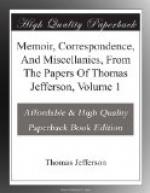with the nebuleuses of Messier. 1785 contains
the famous catalogue of Flamsteed, with the positions
of the stars reduced to the beginning of the year
1784, and which supersedes the use of that immense
book. 1786 gives you Euler’s lunar tables corrected;
and 1787, the tables for the planet Herschel.
The two last needed not an apology, as not being within
the description of old almanacs. It is fixed
on grounds which scarcely admit a doubt, that the
planet Herschel was seen by Mayer in the year 1756,
and was considered by him as one of the zodiacal stars,
and, as such, arranged in his catalogue, being the
964th which he describes. This 964th of Mayer
has been since missing, and the calculations for the
planet Herschel show that, it should have been, at
the time of Mayer’s observation, where he places
his 964th star. The volume of 1787 gives you Mayer’s
catalogue of the zodiacal stars. The researches
of the natural philosophers of Europe seem mostly
in the field of chemistry, and here, principally, on
the subjects of air and fire. The analysis of
these two subjects presents to us very new ideas.
When speaking of the Bibliotheque Physico-oeconomique,
T should have observed, that since its publication,
a man in this city has invented a method of moving
a vessel on the water, by a machine worked within
the vessel. I went to see it. He did not
know himself the principle of his own invention.
It is a screw with a very broad, thin worm, or rather
it is a thin plate with its edge applied spirally
round an axis. This being turned, operates on
the air, as a screw does, and may be literally said
to screw the vessel along: the thinness of the
medium, and its want of resistance, occasion a loss
of much of the force. The screw, I think, would
be more effectual, if placed below the surface of
the water. I very much suspect that a countrymen
of ours, Mr. Bushnel of Connecticut, is entitled to
the merit of a prior discovery of this use of the screw.
I remember to have heard of his submarine navigation
during the war, and, from what Colonel Humphreys now
tells me, I conjecture that the screw was the power
he used. He joined to this a machine for exploding
under water at a given moment. If it were not
too great a liberty for a stranger to take, I would
ask from him a narration of his actual experiments,
with or without a communication of his principle,
as he should choose. If he thought proper to
communicate it, I would engage never to disclose it,
unless I could find an opportunity of doing it for
his benefit. I thank you for your information
as to the greatest bones found on the Hudson river.
I suspect that they must have been of the same animal
with those found on the Ohio: and if so, they
could not have belonged to any human figure, because
they are accompanied with tusks of the size, form,
and substance of those of the elephant. I have
seen a part of the ivory, which was very good.
The animal itself must have been much larger than
an elephant. Mrs. Adams gives me an account of
a flower found in Connecticut, which vegetates when
suspended in the air. She brought one to Europe.
What can be this flower? It would be a curious
present to this continent.




